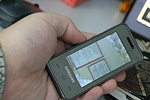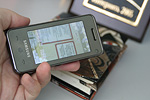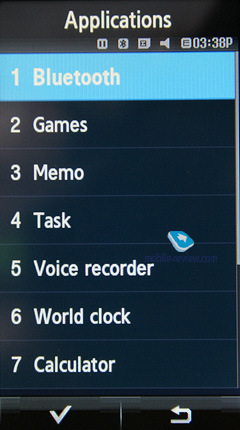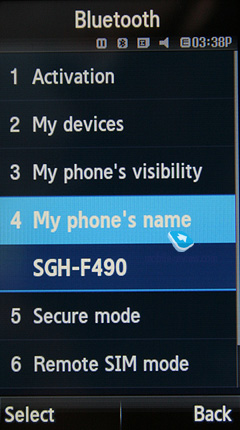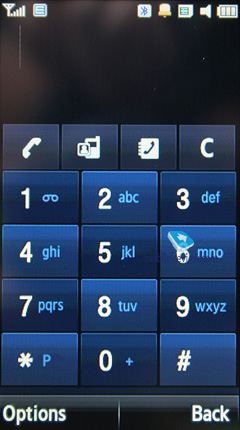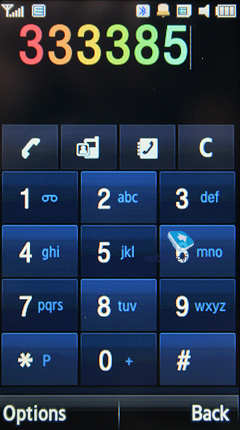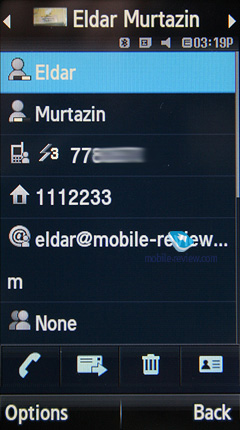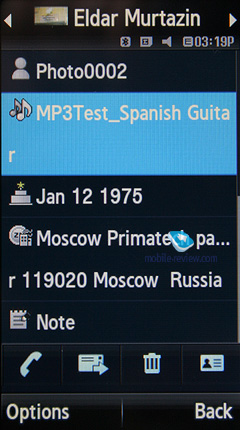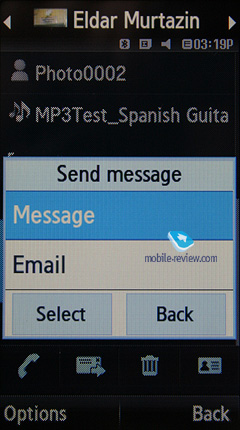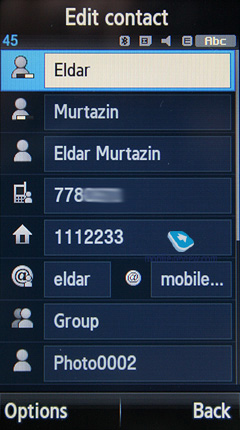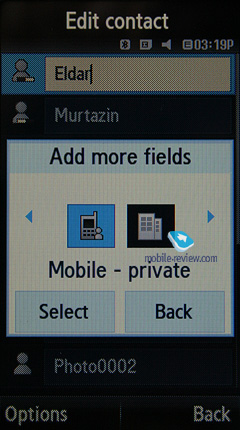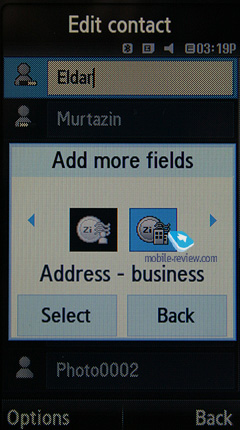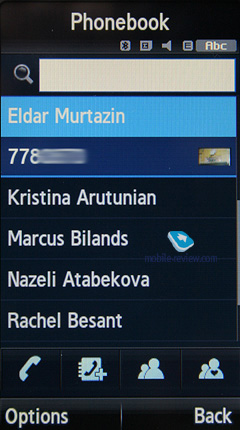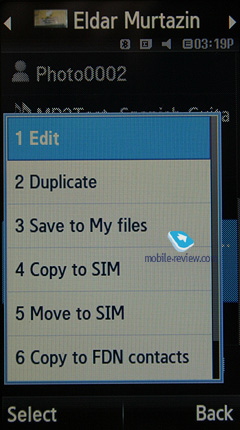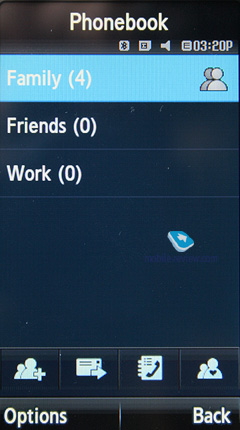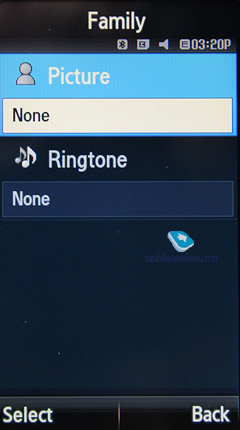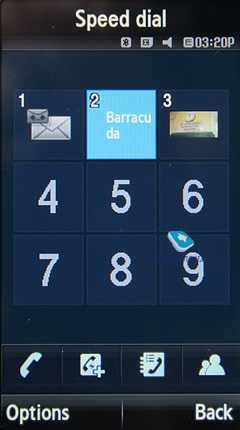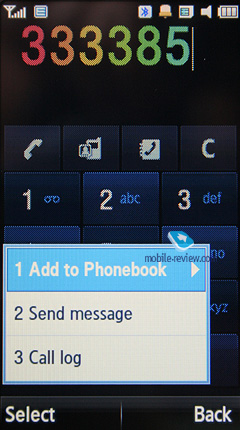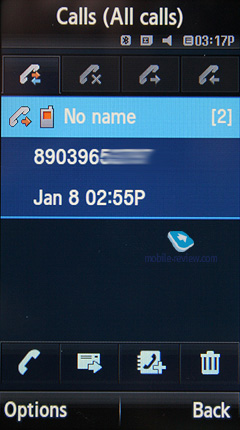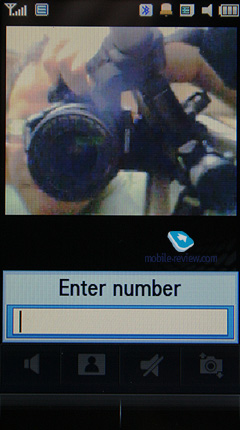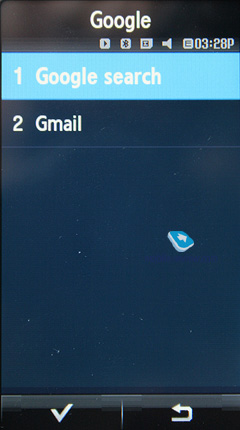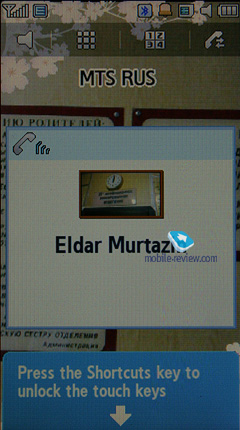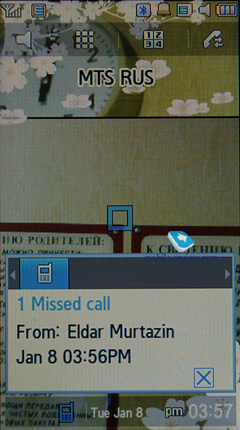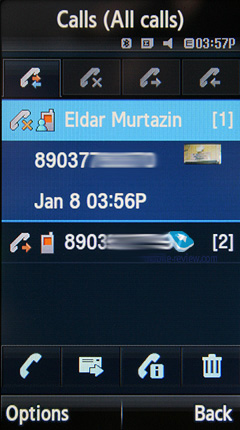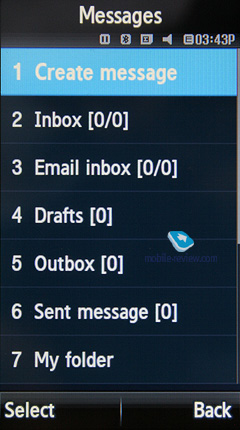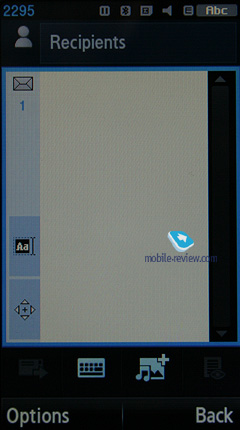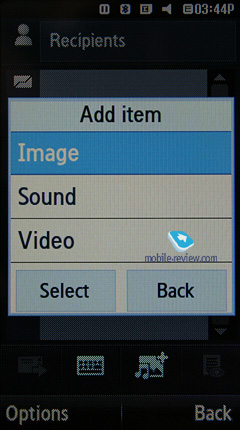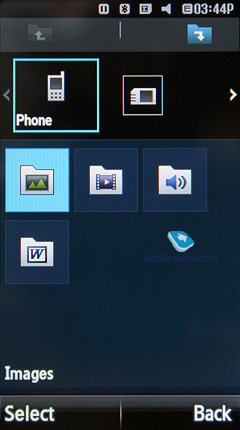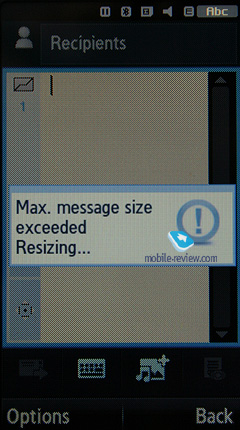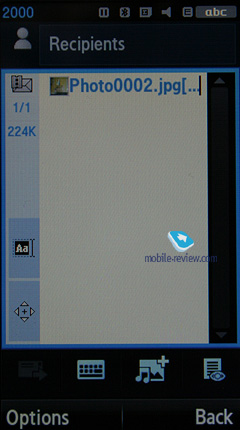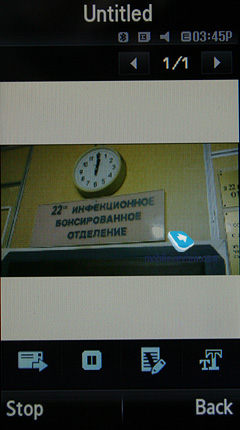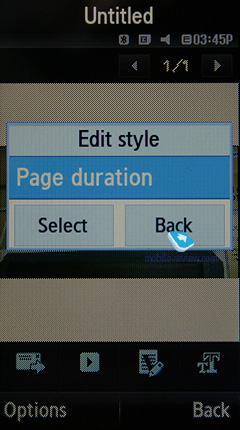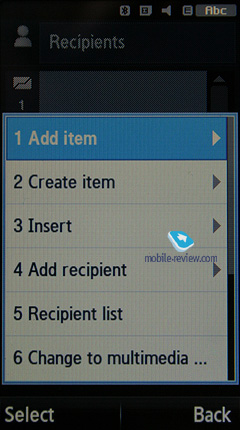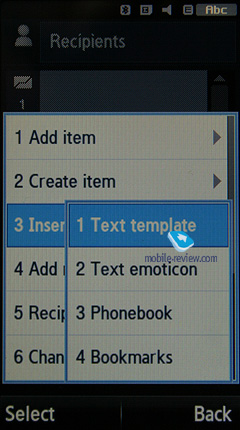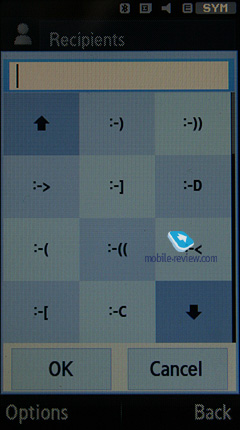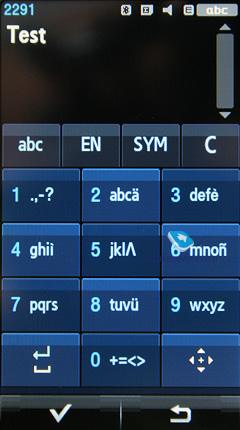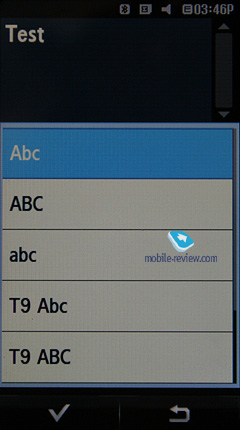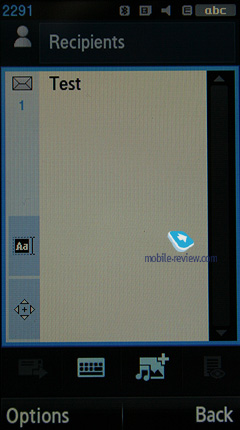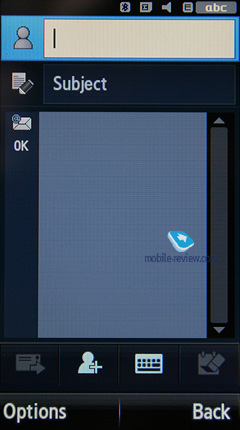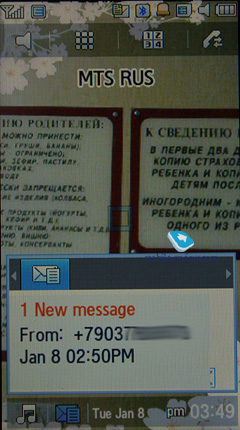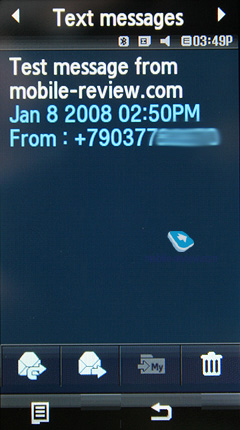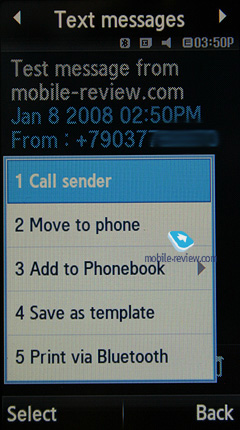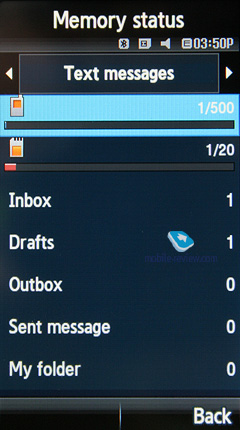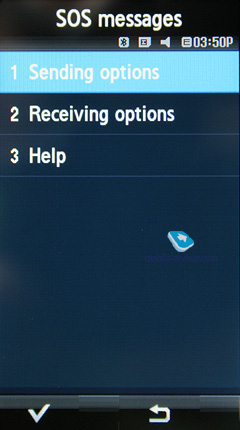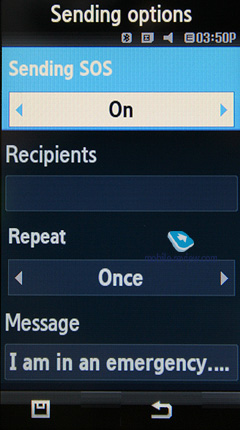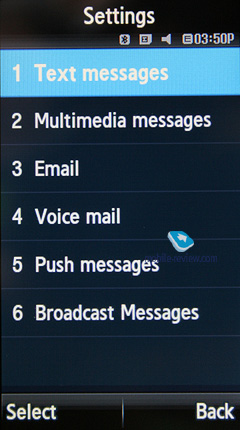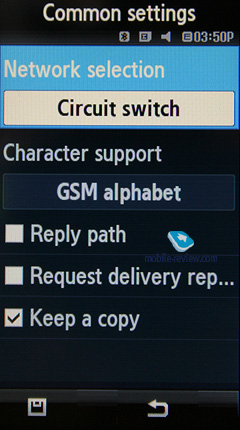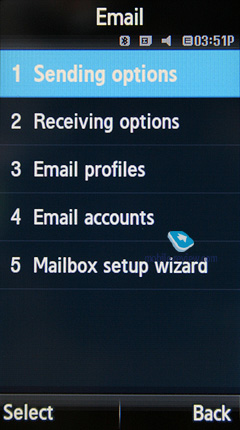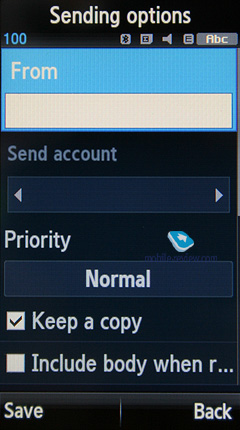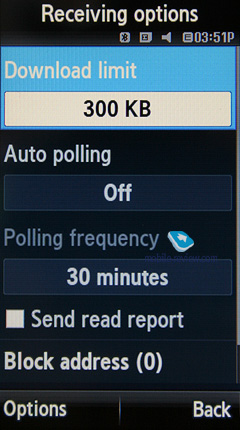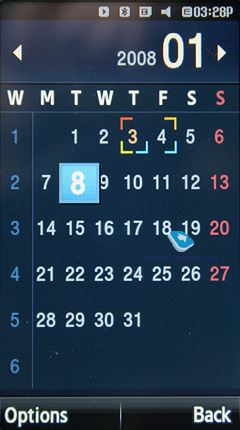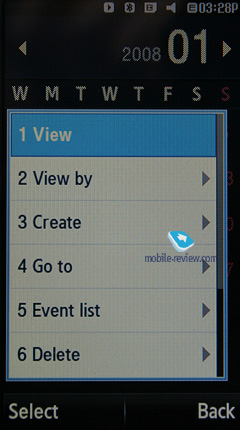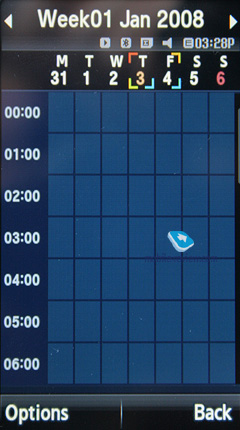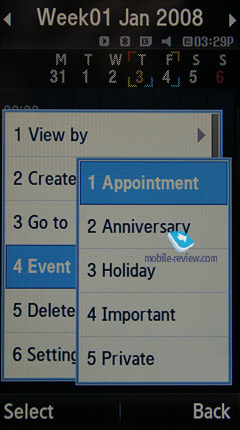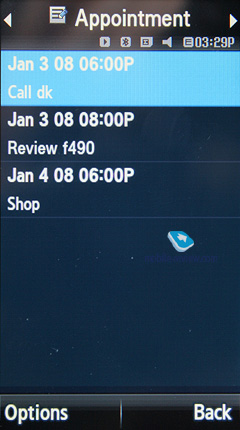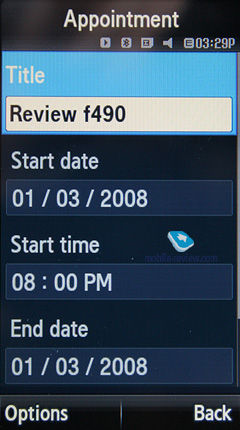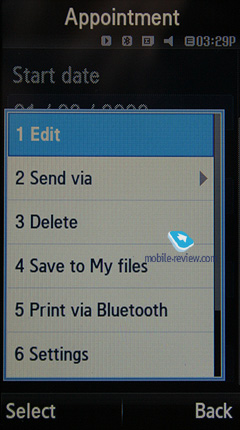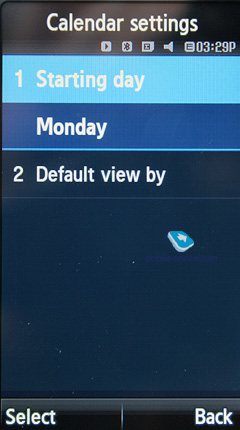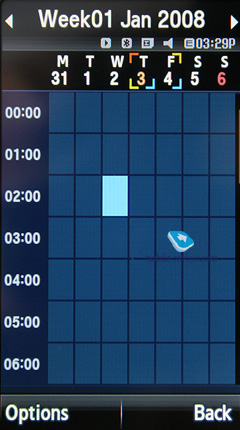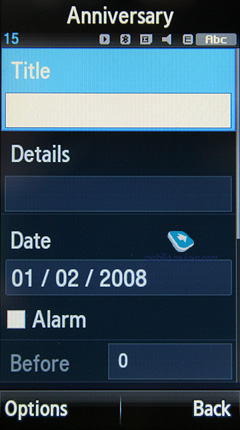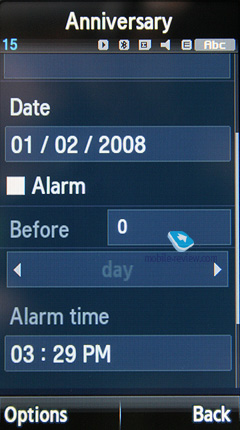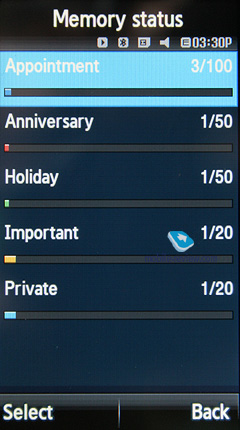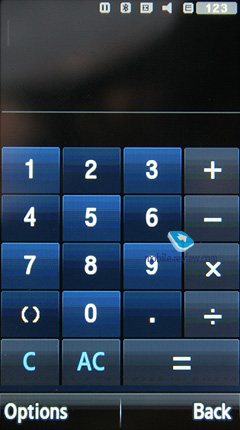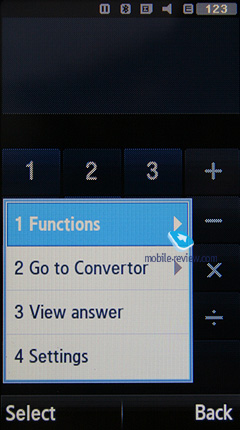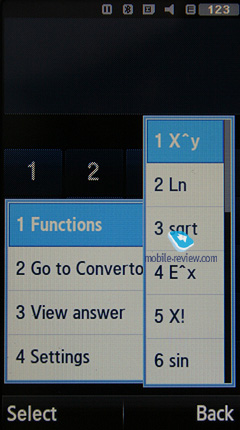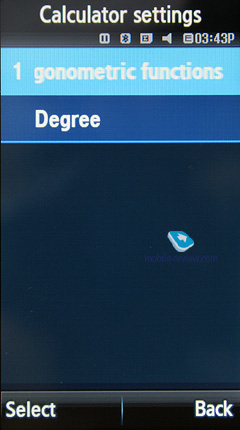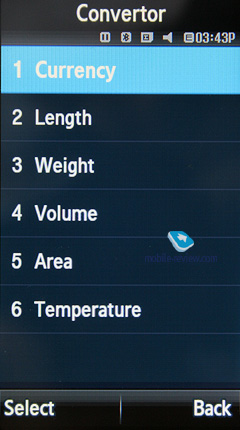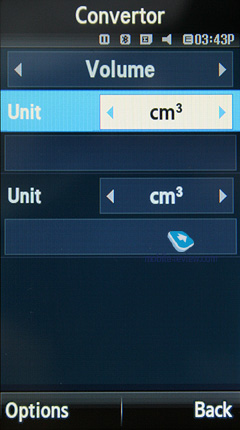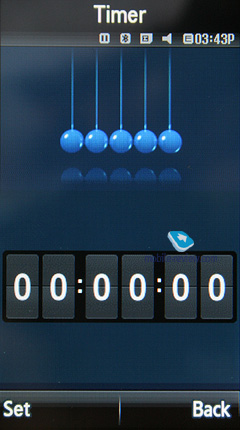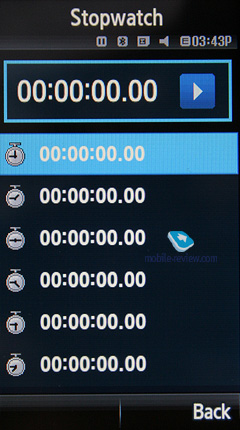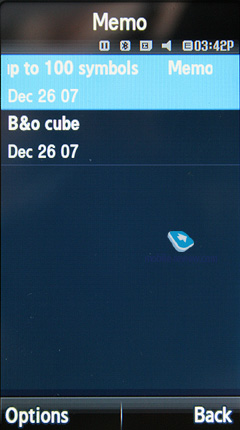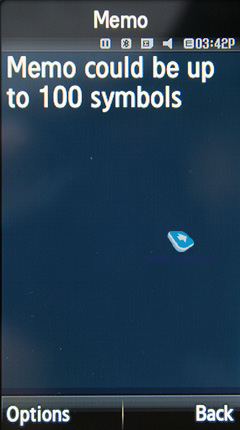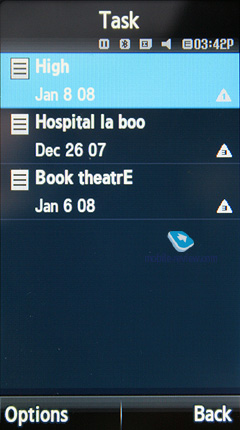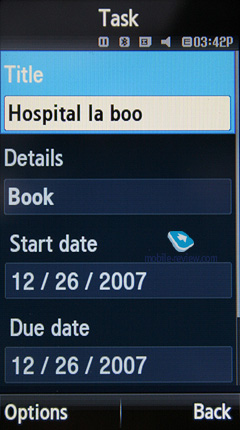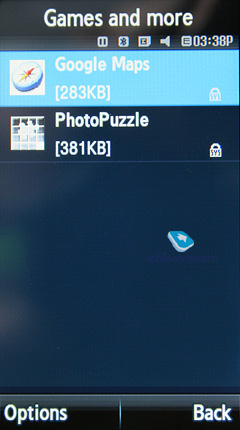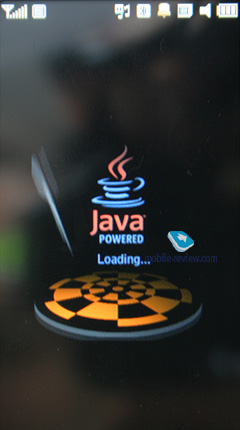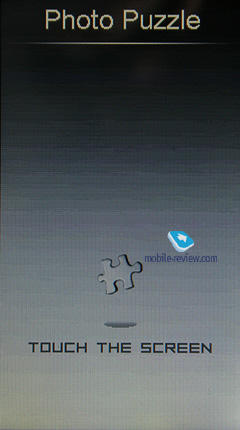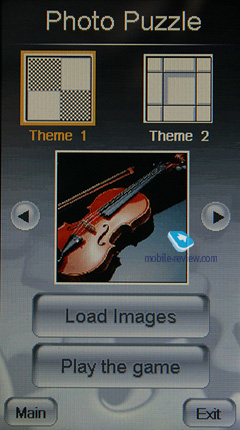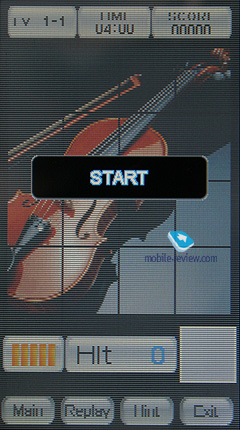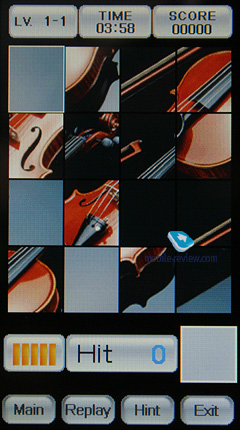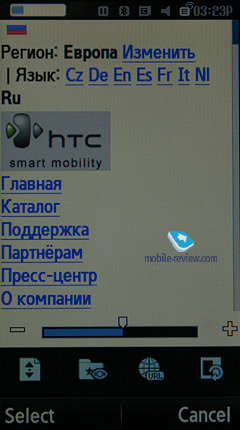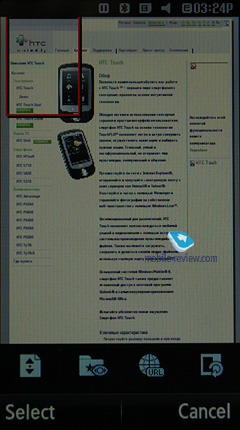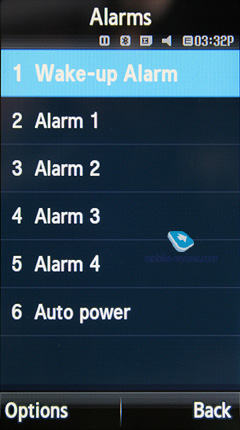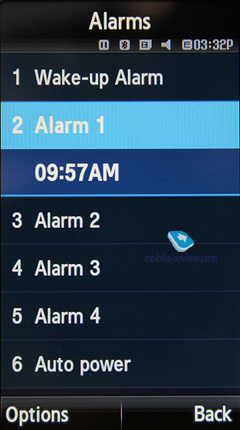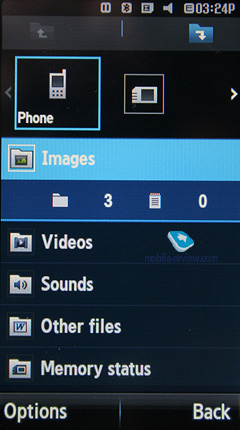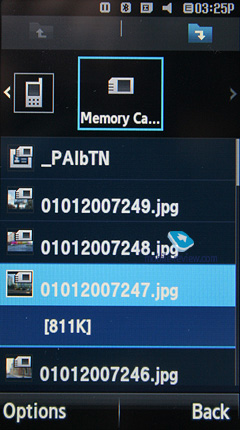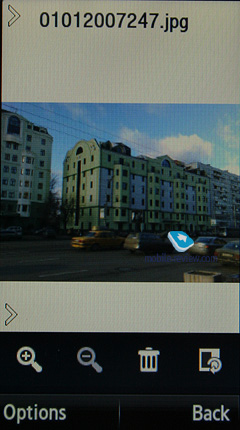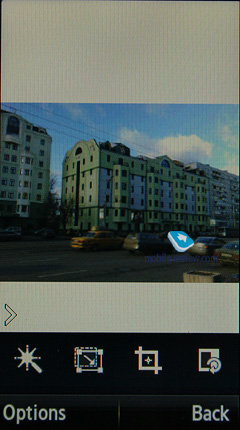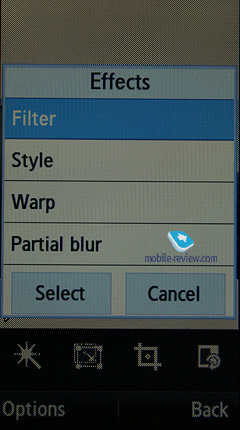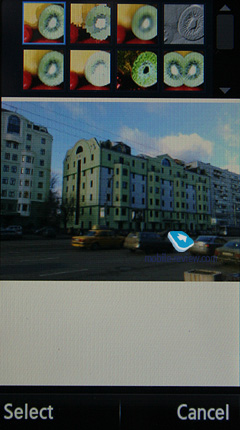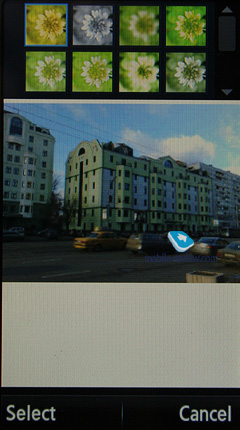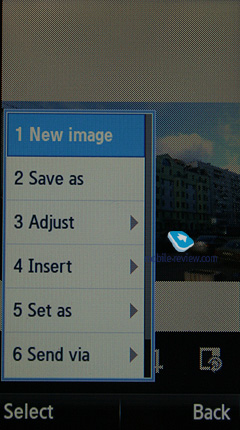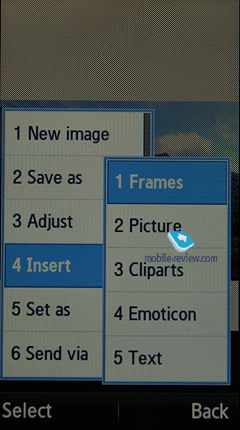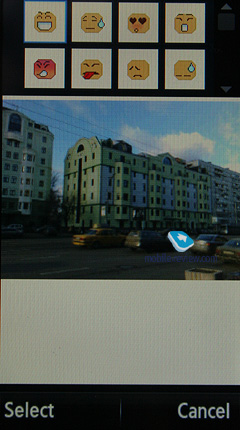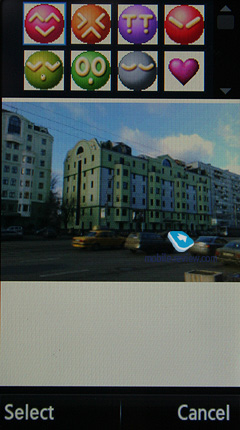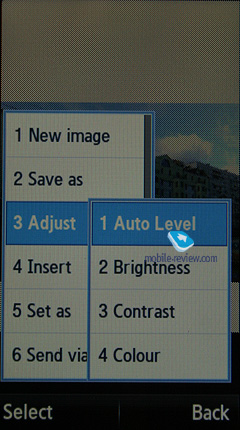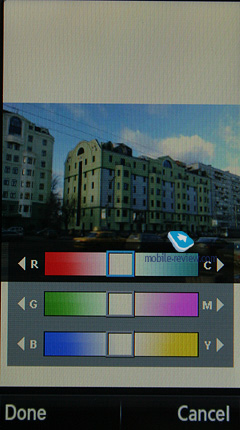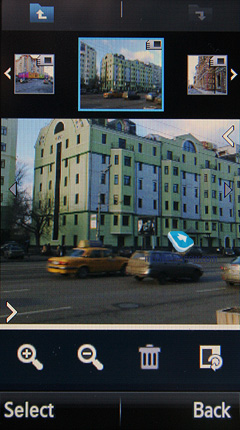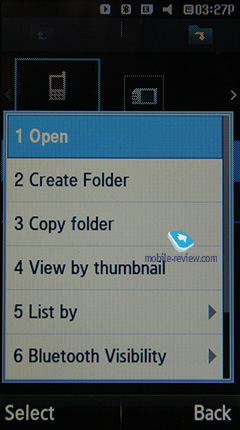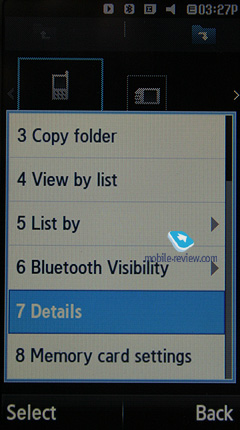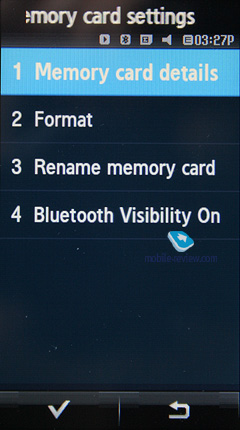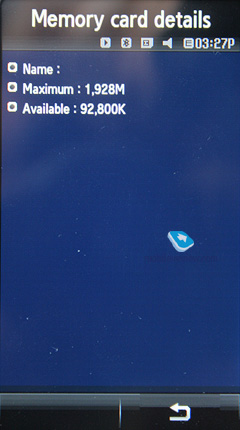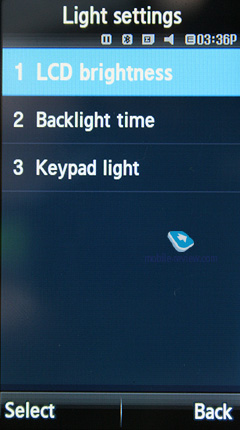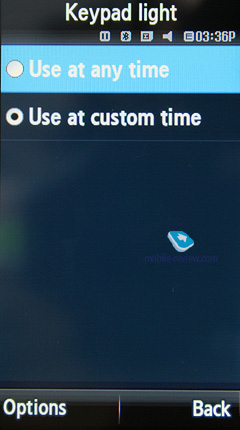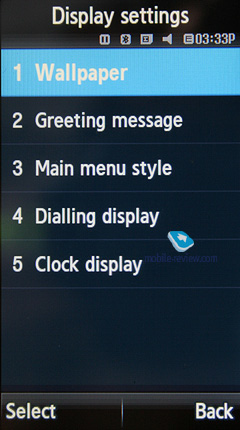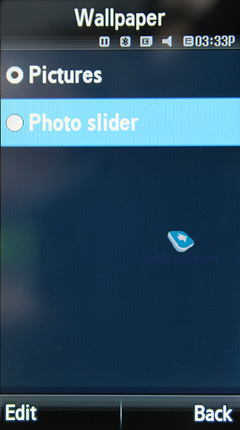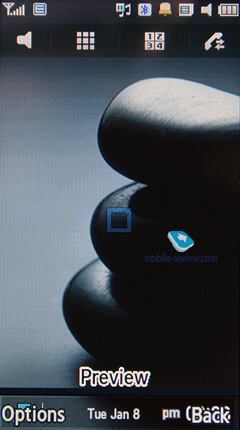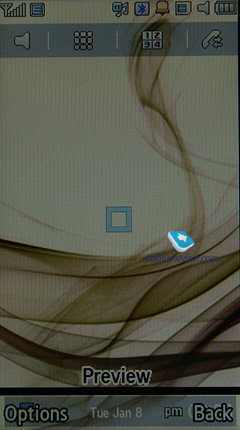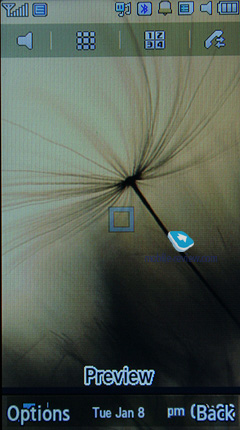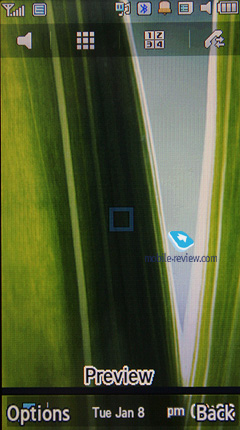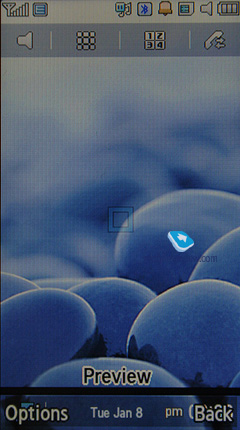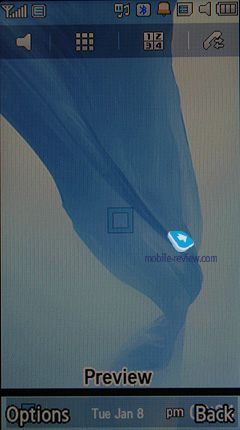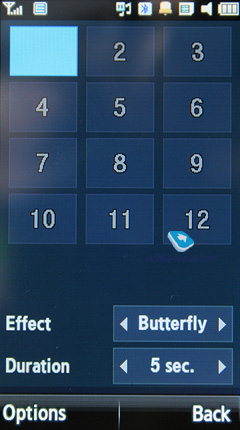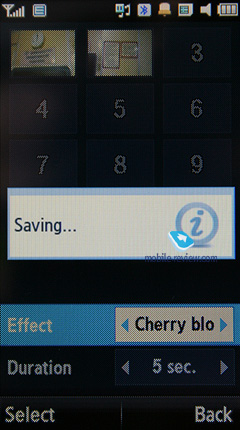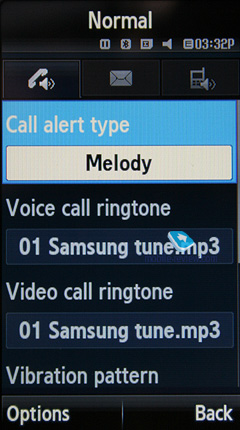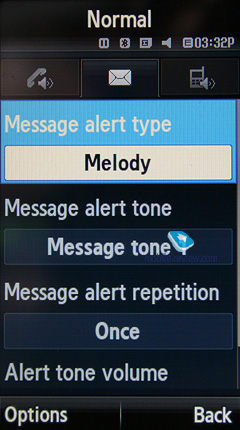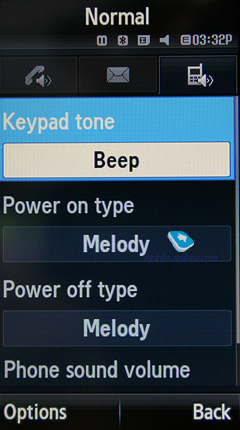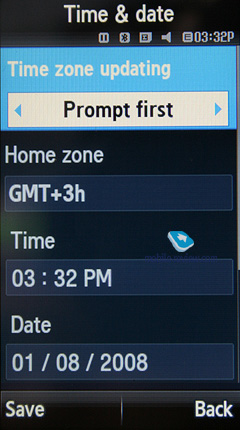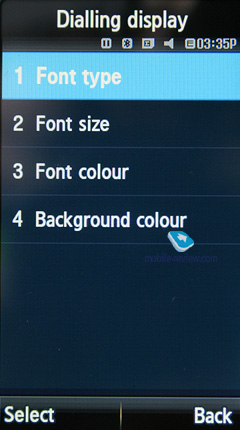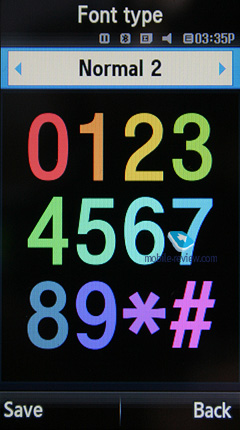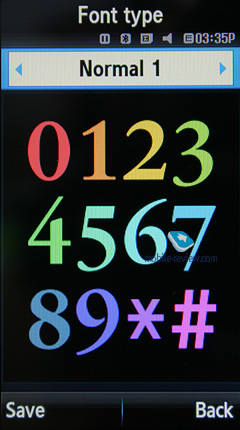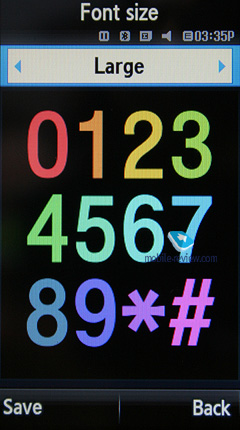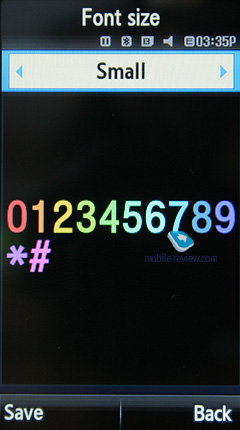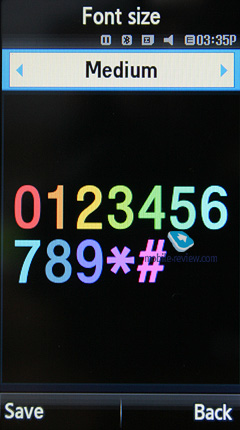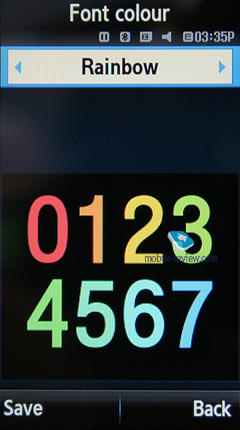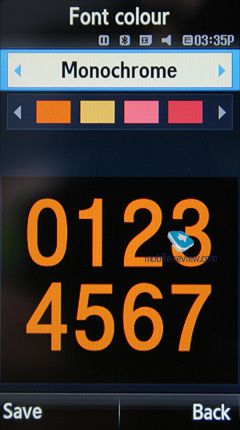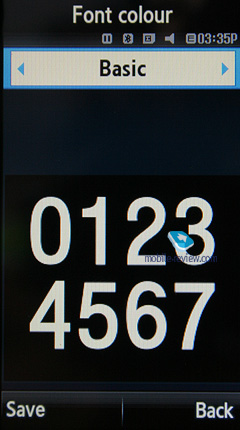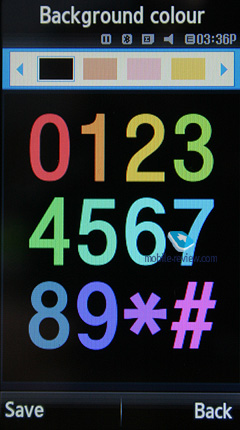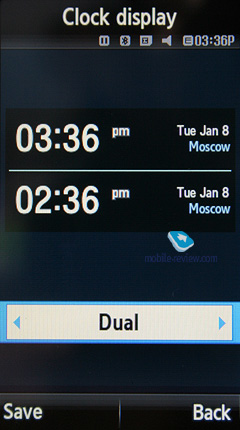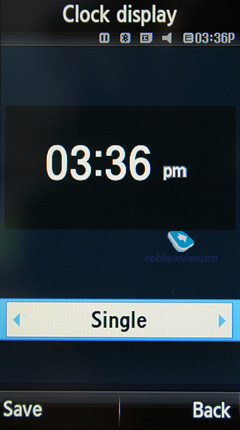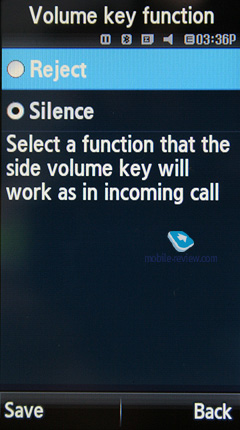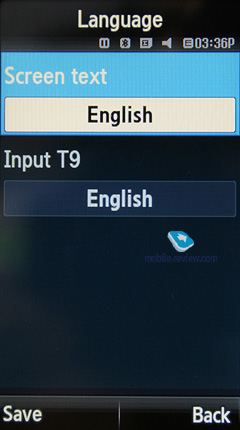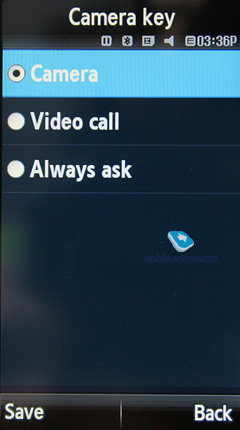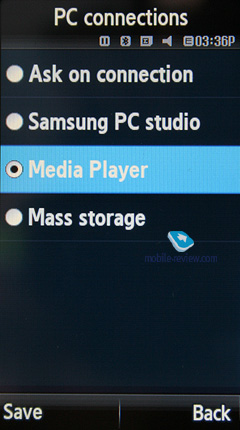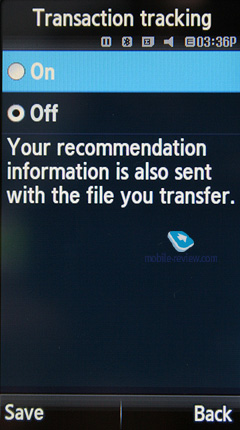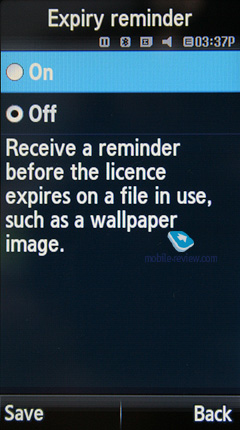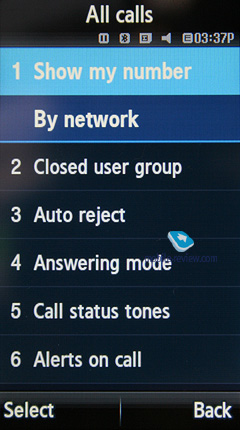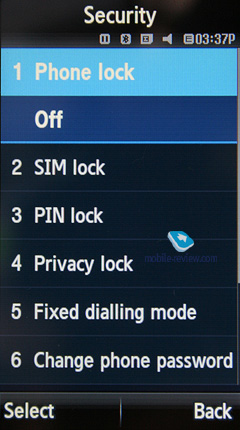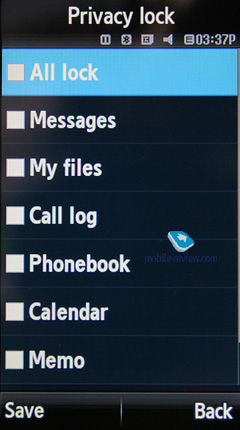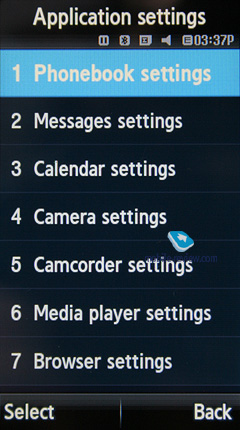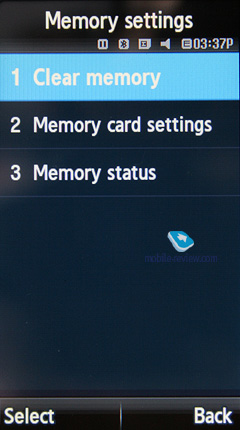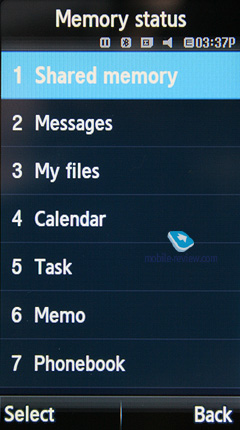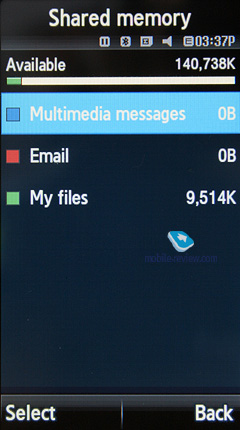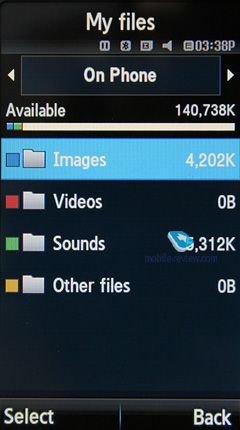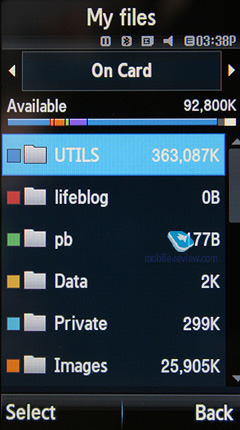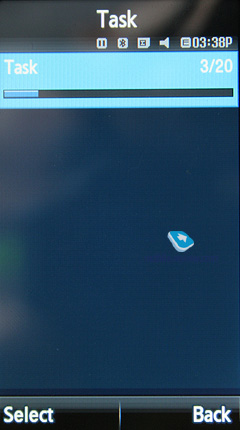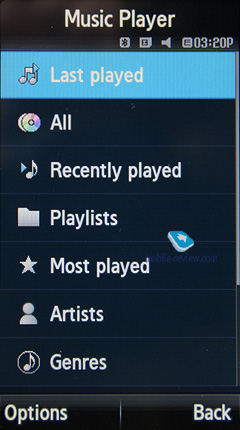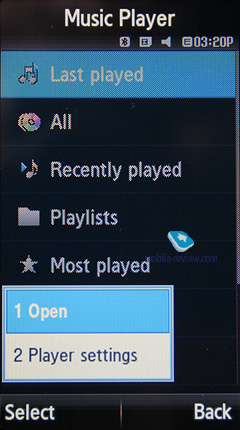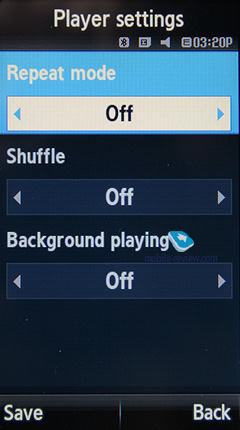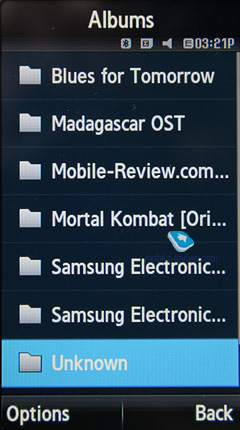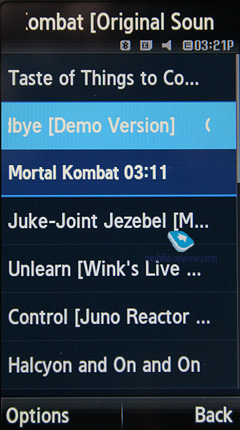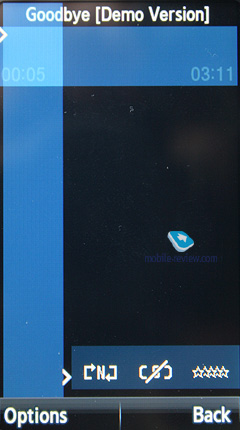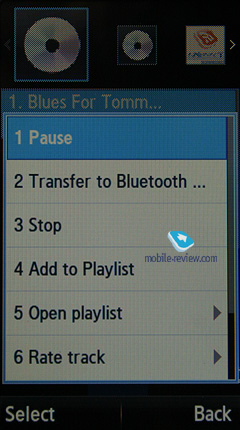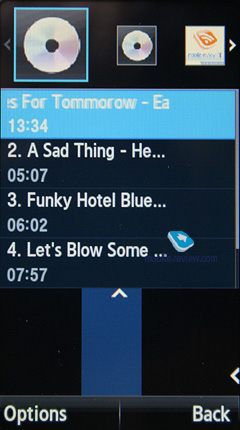|
|
Review of GSM/UMTS-handset Samsung F490
Live photos of Samsung F490
Table of contents:
- Positioning
- Design, size, controls
- Display
- Battery
- USB, Bluetooth, connectivity
- Memory, memory cards
- Camera
- Menu and Croix UI
- Phonebook
- Call log
- Messaging
- Organizer
- Applications
- WAP
- Alarm clock
- File Manager (My files)
- Settings
- MP3-player
- Watching video with the F490
- Picsel Viewer
- Competition
- Impressions
Sales package:
- Handset
- Charger
- USB data cable
- Software CD
- User Guide
Positioning
The Samsung F490 is simply doomed to get faced off against the Apple iPhone over and over again, thanks to its resembling form-factor, missing hardware keys on the front fascia, touch-sensitive display and pretty much identical dimensions. The iPhone buffs readily put the F490 into the “Clones” trashcan, although in reality it takes no cues from the iPhone in positioning or feature pack. Designing this handset, Samsung wanted to offer a hi-tech device sporting some offbeat smarts. On top of that, the F490 enjoys a touch of fashion, but doesn’t exaggerate it. Why so? Simply because the maker’s portfolio already has the Samsung Armani (P520), which has assumed the role of a fashion-savvy handset, while standing very close to the F490 spec-wise.
It is ironic, but the Samsung F490 along with many impending handsets and previous offerings running this platform is nothing more but Samsung’s reaction to LG’s solutions, specifically the LG Prada. And as far as the Samsung F490 is concerned, its direct competition is the LG KU990, so leave this rivalry with Apple out – these are two totally different phones, with the former having no focus on multimedia, and delivering with its calling features instead. It turns out that the F490 is a feature phone powered by a touch-sensitive display, which unties the maker’s hands in certain ways, and makes for a more fetching device overall.

Within Samsung’s own range, the F490 is a follow-up to the Samsung F700, differing from the latter with its 5 Mpix camera (against the 3 Mpix unit found in the senior model) and missing slide-out QWERTY keyboard. And that’s pretty much about it, but these differences enable the company to position the F490 at a lower price point - 100-120 Euro lower, to be specific – in spite of its more capable camera.
Samsung’s handsets are very popular with women, who normally have propensity for impulse-driven purchases. The Samsung F490 is also more of a see-it-and-buy-it phone, yet aimed at men. In our opinion, the men/women ratio will favor men at 70%, since the F490 doesn’t have the visual appeal to get to a woman’s heart, or it may seem to pack too many bells and whistles. Not that I’m questioning the ability of women to come to grips with hi-tech gadgets, by any means. The fact of the matter is that this model is very different from the previous experience of women, who are known for being conservative, as long as it is not a flashy and eye-catching toy, which the F490 is not, no matter how you look at it.
Techi may find it somewhat interesting, but there are no reasons to believe they will be overly enthusiastic about the F490. This is one of the first models in the family, which will be followed by other offerings employing similar concepts.
Back to the table of contents >>>
Design, size, controls
The phone measures 115x53.5x11.8 mm and weighs in at 102 grams. Physically, the F490 is a typical plasticky candy-bar phone, with the rear clad in the same materials, although they tried to give it the looks of unpolished metal. But this is only a visual effect – this type of plastic is prone to scuffs and scratches, that tend to keep a low profile as long as they are skin-deep, but will surely surface if there is something serious.



The F490 is palm-friendly, and delivers pretty much the same feeling as the Apple iPhone, although it could well use some robust feel to it.





The front fascia has a titan-esque mirrorish rim framing the display, which, in theory, should distract the user’s attention from smudge and grease on the protective layer. While handling the display without a stylus, it gets all muddy in an instant – we would lie to you if we called it overly mud-prone, the F490 is quite average in this sense, as many other phones do no better than this.

Topping the display is the front-facing camera, no other hardware keys on the face, though, below the screen are three touch-sensitive buttons lit in white.

The upper edge houses the 3.5 mm audio jack, covered by a plastic flap. The left-hand side features the headset/charger socket, also hidden behind a plastic door. A tad below is the volume rocker. Positioned more towards the top are the holes for a carrying strap.

Look at the right-hand spine to find the Hold/Power slider key, as well as the application switches, menu shortcut button and a dedicated camera key. The microphone of the F490 is perched at the bottom. The camera lens, alongside the LED flash is housed on the phone’s underside.

Back to the table of contents >>>
Display
Since the F490 is on the large side, they have managed to fit a 16:9 display on it, sporting the resolution of 240x432 pixels and measuring 3.2 inches from corner to corner and capable of showing up to 262K colors. On top of that, this TFT display is touch-sensitive (Capacitive Touch Screen technology). The picture quality was never an issue with the F490 – colors were quite natural and soft. Unlike other Samsung’s displays with smaller diagonals, this one doesn’t have impressive and flashy colors on offer, but the question is, whether it really needs them.

The F490’s menu, employing a single-tone theme, doesn’t do the display much justice, but when you get to viewing pictures and photos – that’s the place where the screen’s real talents surface. While it is very handy for viewing photo content, the picture turns out to be somewhat grainy, stealing the title of a perfect video player from the F490.
The screen accommodates up to 14 text and 3 service lines. The font size is pretty big and thus easy to use in various environments.
Samsung-branded offerings also employ the VibeZ feature so as to make the casing vibrate a little, confirming your actions. Unlike the Samsung Armani, the F490 gives you a buzz upon any key press – be it when dialing a phone number our typing out a message. Also, the vibrations going through the display, when tapping numbers and letters, are different but both are tactile.
Now for the shortcomings of the Samsung F490 – there are two of them, both are typical for this technology. The first one is misclicks, when the device responses in an awkward way, typing a couple of letters instead of only one you tapped. And the other letdown manifests itself when you accidentally touch the display’s surface with your palm (basically only counts for people with big hands).

Back to the table of contents >>>
Battery
The handset utilizes an 880 mAh Li-Ion battery, rated for 220 hours of standby and 6 hours of talk time. In Moscow the F490 lasted around 2 days (an hour of calls, a couple of messages a day, very little email and up to an hour of music). Those who are into mail and web, will squeeze around a day of operation from the F490. But in general, this handset can stay up and running for 1-2 days, and unfortunately, there is no extra battery cover for this handset. It takes the phone around 2 hours to charge up.

Back to the table of contents >>>
USB, Bluetooth, connectivity
Bluetooth. The model supports various profiles, such as Headset, Handsfree, Serial Port, Dial Up Networking, File Transfer, Object Push, Basic Printing, A2DP. EDR-enabled Bluetooth 2.0 is onboard. The headset management is flawless, everything is standard here.
USB-connection. In the menu you may select one of three modes: Media, Mass Storage, Samsung PC Studio. No Modem mode available with the F490, there is even no such option in PC Studio. I hope it will come along a bit later.
While in the USB Mass Storage mode, the F490 shows up on the desktop without requiring you to install any additional drivers, so right after plugging in it’s ready to work. Data connection speeds top out at 600 Kb/s.
You won’t be able to use the F490’s Bluetooth connectivity at the same time as USB – it will require you to disable Bluetooth regardless of its status (connected and transferring data or not), which is very awkward.
When connected to a PC via USB, the F490 automatically recharges itself.
For GSM-networks, the F490 comes included with EDGE class 10.
Back to the table of contents >>>
Memory, memory cards
The phone ships with 160 Mb of memory onboard – this storage space, give or take, is available to the user right out of the box. The memory card (hot-swappable) is displayed as a separate section, so you can’t access both memory types at a time. The F490 also comes with a file manager, enabling you to copy files to/from the memory card. In our test the handset had no problems handling a 2 Gb microSD memory card, whereas an 8 Gb unit remained unidentified.

Back to the table of contents >>>
Camera
The handset employs a 5 Mpix camera with no autofocus (CMOS). Picture quality is average in daylight, we found nothing to praise in the F490, though. The LED flash helps a little when shooting nearby objects.

The touch-sensitive display brings about a couple of fresh changes to the way the camera interface is handled. This way, you pick menu items right from the screen, while the display acts as the viewfinder. You zoom in and out by sweeping your finger across horizontally, which isn’t particularly handy. The following resolution settings are available with the F490:
- 2448x1360 pixels;
- 2160x1200 pixels;
- 1728x960 pixels;
- 864x480 pixels;
- 432x240 pixels;
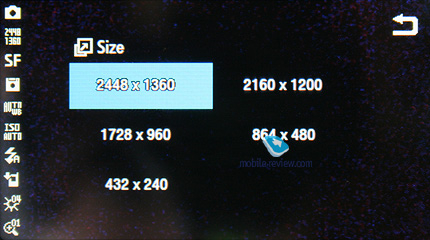
Four quality modes are found in the camera:
- Super Fine;
- Fine;
- Normal;
- Economy;
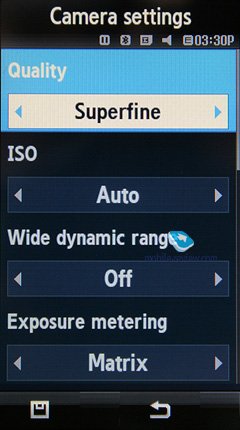
You should always stick to the best quality settings, as it doesn’t make your shots overly big, yet makes them look considerably prettier.
Speaking of the standard options you get with the F490, there is White balance (Auto, Daylight, Incandescent, Fluorescent, Cloudy). You will also be able to adjust ISO, as well as the exposure settings. The handset also packs an x8 digital zoom which doesn’t work for max-resolution images. More options, like scene settings and Anti Shake, are also at your disposal.
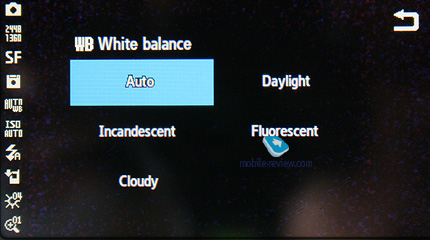
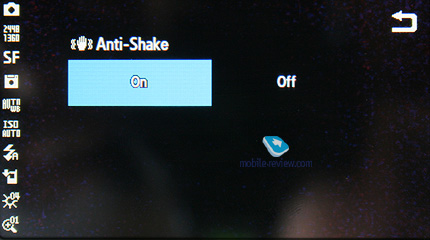
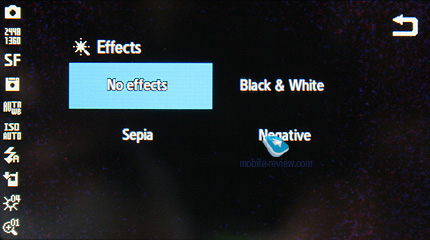
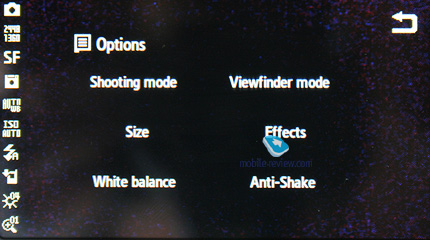


The bundled flash gives too much light to nearby objects, which takes a whole lot of value from it. All up, the camera’s picture quality is below average, as the snaps it takes don’t look good anywhere but on the handset’s display.
 |
 |
| (+) maximize, 2448õ1360, JPEG |
(+) maximize, 2448õ1360, JPEG |
 |
 |
| (+) maximize, 2448õ1360, JPEG |
(+) maximize, 2448õ1360, JPEG |
 |
 |
| (+) maximize, 2448õ1360, JPEG |
(+) maximize, 2448õ1360, JPEG |
 |
 |
| (+) maximize, 2448õ1360, JPEG |
(+) maximize, 2448õ1360, JPEG |
 |
 |
| (+) maximize, 2448õ1360, JPEG |
(+) maximize, 2448õ1360, JPEG |
 |
 |
| (+) maximize, 2448õ1360, JPEG |
(+) maximize, 2448õ1360, JPEG |
 |
 |
| (+) maximize, 2448õ1360, JPEG |
(+) maximize, 2448õ1360, JPEG |
 |
 |
| (+) maximize, 2448õ1360, JPEG |
(+) maximize, 2448õ1360, JPEG |
 |
 |
| (+) maximize, 2448õ1360, JPEG |
(+) maximize, 2448õ1360, JPEG |
Video. The device captures video in two resolutions – 240x320 pixels and 176x144 pixels at up to 15 FPS. Its video quality, however, is nothing special.
Ïðèìåð âèäåî (3gp, 1,08 ìá) >>>
Back to the table of contents >>>
Menu and Croix UI
The entire range employing touch-sensitive displays comes with a Samsung operating system and user interface standing very close to what you currently see with the company’s latest solutions. At the same time, there are a couple of new touches added for touch-screen based devices. They have tailored the interface to make it get along with touch-displays, so the new UI goes by the name of “Croix” (French origins of the word, where it literally means “a cross”). Another model enjoying this user interface is the Samsung U700, the same OS version is installed in the Samsung Armani.
Let’s see how the user can benefit from this particular interface version and what’s so special about it. While in the standby mode all you will see is the clock, but sweep your finger across horizontally to bring up the calendar displaying the current month’s schedule. The bad thing about the pop-up calendar is that you can’t scroll between months, which is especially frustrating when a month is drawing to a close, and obviously you want to check out days to come. Again, this is a just a calendar that has nothing to do with the Organizer’s event, which are not displayed in this pop-up window.
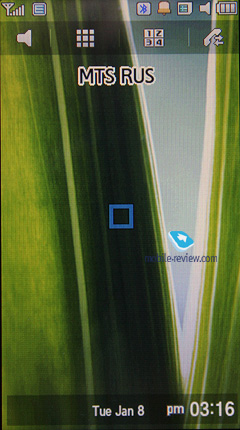
Sitting in the centre of the display is a blinking square which unfolds into four shortcuts to call logs, player, messages and phonebook once you tap it. You can also jump to the call log by pressing the pick up key.
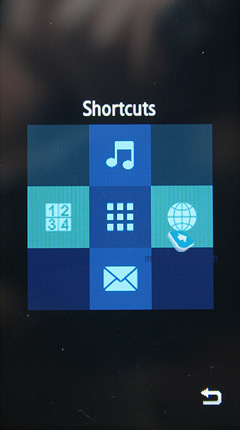
You can enter the main menu by pressing the icon at the top of the screen. The numeric keypad is called up from the standby mode hands down, which is also pretty convenient.
The main menu is displayed as a 3x4 grid, where every item you hover over is placed inside a cross which wanders around from item to item – hence the name “Croix”, pretty easy to guess.
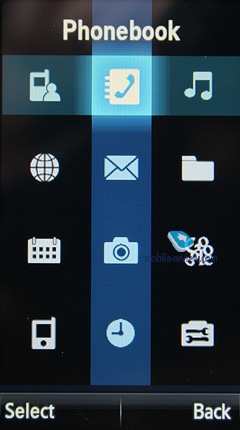
The touch-sensitive display is easy to handle – you tap the item you need, then bring up a data input field by double-pressing it, since the first one will select it, and the next one will enabled the on-screen keypad.
All texting is done via the on-screen keyboard, which is almost identical to that of conventional looking handsets – it houses twelve buttons with a batch of symbols attached to each, so in order to type some particular letter you will need to tap one of these buttons sequentially. Naturally, many will wonder why the F490 comes with no QWERTY-keyboard if it packs a touch-sensitive display. Well, while it makes for a tad speedier typing, the user also gets more misclicks, which negates all advantages of a virtual thumbboard. Essentially, touch-screens are great for moving around menus, not texting.
You also opt for the T9 predictive text input system for typing, but the way it is implemented in the F490 leaves much to be desired. When texting you see a text box topping the display, where words pop up, and the bad thing about the handset is that it doesn’t actually predict words, meaning that you won’t see a word until you have entered it. On a very rare occasion when two words share the same key sequence, you will be allowed to use the directional arrows to scroll through the list of alternatives, but you won’t see it either. In my opinion, there is no reason to disable the T9, as you won’t boost your text input speed this way. One more thing marring the handset’s messaging department is that while you actually can add words into the dictionary, you will have to go through hell to do that.
The handset allows you to toggle between any of the preinstalled languages. From the menu you can use the text editing mode, when you will be able to select a fragment, but not copy it. Being able to select text, however, also comes in handy when you need to alter fonts or something.
While all lists have their items indexed, you will never be able to utilize shortcut number navigation for lack of a hardware keyboard. The only reason they keep these shortcuts is because of hybrid models with both large touch-sensitive displays and thumbboards, like the Samsung F700.
All menus have the icon bar at the bottom, featuring the OK key, which does the same thing as pressing the display and the Back button, which is really essential on the F490 – if you have a drop-down menu open, the only option for closing it is pushing this key. The fact of the matter is that you can’t go back by just clicking on free space around that menu with the F490. The third key available in the bar calls up the quick access menu.
All applications, whose menus provide you with a number of options, also house removable icon bars with them, which is an extremely convenient layout.
Another positive thing of note is that you can pull up extra tool bars onto the display. When viewing photos, for example, this tool bar displays thumbnails from neighboring files, so that you can select then in one touch. For messaging, these may be extra panels with some particular functions.
Ergonomics-wise, the F490 is not always intuitive, but overall, it is an easy-to-use device. Had the T9 mode been a little better, we would have experienced a considerable boost in texting speed over feature phones, but, regrettably, that’s not the case with the Samsung F490. On the other hand, this offering is very close to the LG Prada spec-wise.
Back to the table of contents >>>
Phonebook
Contacts can be accessed only from the menu; you will see a list that contains all entries from both the SIM-card and phone’s memory. The second tab comprises contact groups, so that you can switch to them in no time. Third tab – contact groups. The list doesn’t feature images assigned to entries.
The field beneath the name is the default number, which can be picked manually from the list of submitted numbers for a particular contact. Quick name search by first letters is supported; there can be up to twenty of those, for any language. Once you tap the entry you will go into a detailed view of the selected entry. There you will see a thumbnail, if any. It can be an image, a photo or a video clip. Each entry can have up to 5 phone numbers of different types (mobile, office, home, fax other), one of them will be main number (by default it is the first one you entered). All fields are hardwired.
There are two lines for First Name and Last Name (search is performed only by the former), these fields get merged when displayed in the general list, and First Name comes first. For example Eldar Murtazin will be shown only in this order. Length of each field is 20 characters for any supported input language. You can also switch languages on the fly when entering a name.
All entries, regardless of language, are sorted out in the following way – all contacts with headings made in a local language (Russian, for example) go first and then those with names in English. This is a rather convenient and handy list sorting system. Taking into account fast language switch option during the search, it’s clear that no language will spoil the experience of working with this phone. The list can be sorted by first or last name.
But let us return to the information entered for a contact. Apart from phone numbers, e-mail address (there may be several of them), a little text memo can be submitted on top of all that. Any music file (including MP3) can be picked as a ring tone for a contact. Three caller groups are provided by default with the possibility for creating any number of additional groups, setting a personal melody and image for each (by default there are three groups). SMS alerts are not customizable.
The phonebook is capable of holding up to 1000 contacts with filled in data fields. Even if all the available blanks are not used, the cap won’t get any bigger and will still make one thousand. It is possible to specify in the settings where all new numbers should be kept by default. There is also an option for moving entries from the SIM-card, although the reverse action is denied. According to the developers, PC (MS Outlook in particular) is best for data synchronization with the F490. Any contact in the form of SMS/MMS, mail message or other text file can be quickly sent through Bluetooth to another device. There are no problems with sending, and the phonebook entry gets beamed to another device, where it is read without any trouble.
The phonebook may contain a business card as well, though its structure copies all the fields found in a regular contact in the phone book.
There can be up to eight numbers in the fast dial list; separate numbers tied up with a single contact may appear on this list as well. The chosen entry (not of the phone number type) is displayed on the buttons as the subtitle.
You can create any number of caller groups, assign up to 20 contacts and customize them with a picture and tune.
On an incoming call, the caller ID picture occupies almost the entire screen.
Back to the table of contents >>>
Call log
Each of the given lists contain up to 30 phone numbers. There is a combined list of all the last calls with an icon indicating call type. You can quickly switch between the lists. The date and time of the calls are displayed in the extended view for separate entries. Calls from/to one number are grouped up, so that the number standing next to the call specifies total number of calls made. As always, the overall time of the calls and their cost can be viewed in this menu (in the case that the service has been enabled).
For individual numbers you can arrange a black list, which will reject all calls coming from these contacts.
From this menu you can also access the list of numbers you received/sent SMS messages from/to (two list), as well as all email addresses you have used lately.
Back to the table of contents >>>
Messaging
Much like other makers, over at Samsung they have forgone that artificial division into SMS-MMS types – you just start composing a message, and only then, depending on the contents, it is attributed to SMS or MMS. The menu still holds an option for switching message into MMS mode (for example when you need to send only text, but to an e-mail address, without calling up the bundled client).
The phone memory can hold up to as many as 500 messages; the handset supports EMS standard compatible with Nokia Smart Messaging. While choosing recipient, you can either select a telephone number from your contacts or pick one from the call lists or groups. All messages are manageable, this means you are at liberty to move a certain number to your black list, in order to make sure all messages coming from that phone number will be deleted automatically; possibility for moving messages to any own folder is also at your disposal. For e-mail you can move not only addresses to the blacklist, but unwanted subjects as well.
There are no size restrictions as far as received messages go, though an outgoing message’s size is limited to 295 KB. As for additional services available with the F490, message rejection and message retrieval type options are onboard. All messages are stored in general dynamic memory, the same goes for e-mails.
Also there is a useful function for sending SOS-messages – when activated, should you find yourself in an emergency, after pressing the volume key four times, the message «I am in emergency. Please help me» will be sent to contacts submitted earlier, all incoming calls from these numbers upon sending the emergency message will be picked up automatically. Recipients (not more than 5), as well as the number of Repeats may be set up manually, while the text of the SOS-message is not customizable.
The bundled mail client is standard in all its components – 5 accounts and the maximum of 100 incoming messages; attachments are also handled by the phone, though there are also several caps – there’s no way you can receive a file more than 500 Kb big, or send one with size exceeding 300 kb. Received files can be viewed via the bundled browser. The F490 doesn't support html in emails, which breaks formatting of most letters you receive, so they become really awkward to read. The mail client found in Samsung-branded phones is now falling behind those embedded in Nokia’s and Sony Ericsson’s solutions.
Back to the table of contents >>>
Organizer
The phone’s memory can store as many as 100 events of one type – meeting. There are other event types as well, like anniversary and holiday, with the maximum capability of 100 events (2x5). The F490’s to-do list can also hold up to 20 entries.
Day and time as well as end time of an event are indicated for each entry. Alert signal and its duration can be adjusted to your liking; repeatable events are available for setting up (repeat time is also manageable as well as the exceptions). The weekly and the monthly calendar views are very convenient with each type of the event having its own color.
Speaking of the organizer’s shortcomings, I cannot overlook the fact that when typing date and time for an event, the end time doesn’t change, which badly hurts its ease of use – other manufacturers make the due time shift automatically (by default any event takes one hour).
Back to the table of contents >>>
Applications
Voice recorder. You can record up to several hours of voice memos with the number of files being unlimited. Basically, limitations on recording duration are set by the user himself, though length of a single recording cannot exceed 1 hour. All the files are stored in a separate folder in the memory bank. The recorder performs well during lectures, conferences and presentations – I could even say that it is a partial substitute for a digital tape recorder.
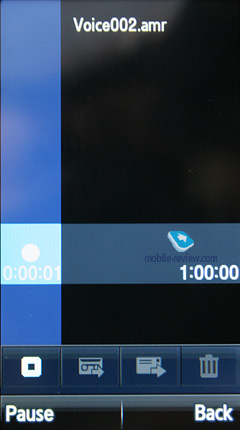
World time is displayed for two chosen cities.
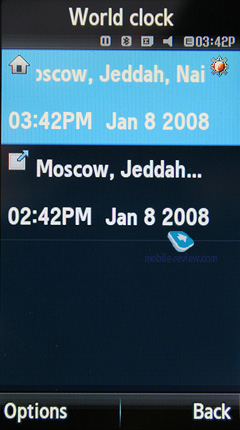
Calculator It divides, multiplies, subtracts and adds and does several more things – quite enough for a mobile calculator.
With the converter, you can operate with different units of measurements as well as with a number of currencies.
Countdown timer and stopwatch have no bells and whistles.
Memo – standard text notes.
Games – the F490 comes installed with PhotoPuzzle. There is no way to upload new games, at least for now. The maker will release a special SDK for Java-games tweaked for this particular model.
Back to the table of contents >>>
WAP
The handset comes with a wap-browser version 2.0 (NetFront 3.4), where apart from JavaScript support, fonts scaling (three types), Smart-Fit (single-column view), full-screen mode (all controls are hidden), page caching, they have embedded a new feature – on-screen ‘mouse’ pointer. Much like Nokia’s S60-powered handsets and Opera Mini, you can view pages with a tiny navigation window displayed. The browser itself packs a lot of goods under the hood and will be appreciated by most users.
While browsing, you will see four directional arrows for moving around web-pages. The usability of this solution is questionable – basically, browsing is not the forte of the F490, despite its pretty decent browser application.
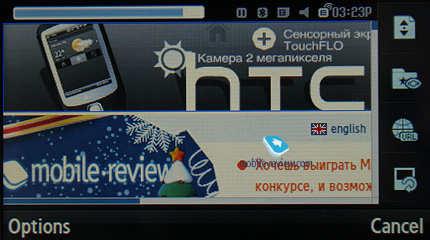
Back to the table of contents >>>
Alarm clock
The handset comes equipped with four alarm clocks, each of them can go off on certain weekdays. You can also pick one of five tunes, or turn to MP3 tracks. In settings it is possible to enable auto power-up when any event triggers.
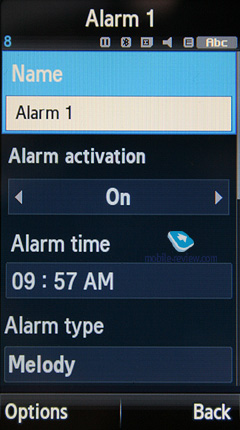
Back to the table of contents >>>
File Manager (My files)
That’s the place to search for all files such as music, pictures, video and sounds. Any uploaded file gets stored here. The disadvantage is that files sometimes are not displayed in the list immediately - in that case you will need to leave the menu and enter it again.
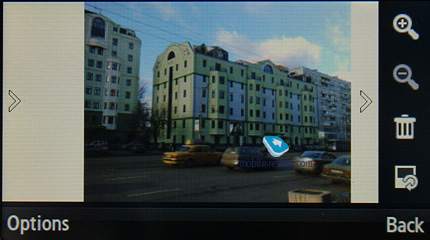
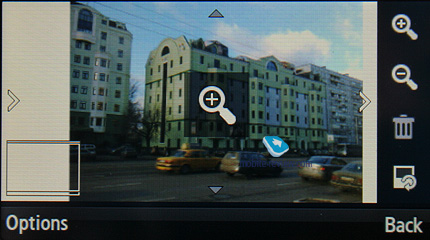
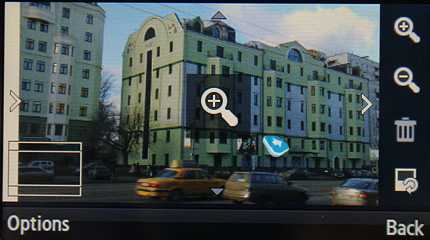



Files and folders can be viewed either as a list or thumbnails. You can mark any number of files. The handset supports Move, Copy and Delete operations, as well as various types of sorting (by type, name or size).
Memory card’s file structure is a slightly different story, as it can be accessed through the main menu, where each item features “Memory card” option.
What I want to emphasize here is that Java applications can’t be uploaded over the air or via any other means, even though the Memory section of the menu claims this feature is supported. In theory, games specially designed for this particular handset can be uploaded on top, but in fact there are only two games of this kind.
Back to the table of contents >>>
Settings
Traditionally this item boasts a standard set of options inside like password protection of selected sections. Keypad light – there are three options at your disposal, one of them is Night mode, implying that backlighting will be active only between 5:00 PM and 9:00 AM and disabled during daytime. If you come to think of it, this feature is nothing more but an illusive replacement for ambient light indicator, which Motorola’s handsets are armed with.
No special or quaint settings are available with the F490. It only comes with an assortment of wallpapers and the ability to swap them randomly. But you can create animated slide-shows with them, apply various effects and thus make your standby screen morph into an eye-catcher.
The F490 comes preloaded with profiles enabling the user to change the settings momentarily.
The font size, as well as its color and style are also adjustable.
The user can also modify vibration power for the VibeZ.
Mobile Tracker – submit a phone number, where notifications will be sent to in case SIM-card was changed – that message will contain number of the SIM-card being used with the handset. This section is protected with password, so that no one other than you or someone else who knows the password could disable the Tracker. Should your device have the SIM-card switched once, the specified number will receive one message instantly, and one more each time a new card is plugged in. A fetching feature which can prove to be of much help in case the handset is lost or stolen.
Back to the table of contents >>>
MP3-player
The player’s interface theme is keyed to the F490’s looks. The point where the lines cross houses the Play/Stop button, drag the horizontal bar to the right to jump to the place within the track that you need. And the vertical bar stands for the volume level. There are two more bars for calling up the settings menu (equalizers, loop, rating) and the track list menu. While the player looks quirky at first, you come to grips with it in a dozen of minutes. As for the rest, it is a typical latest-gen Samsung player.
The integrated mp3 player, supporting random, sequential and cyclic playback, is available with the phone. Mp3 files can be uploaded onto the handset both directly over Bluetooth and through the sync application or Windows Media Player. There are no limitations on tags and names of music files. Bitrates are not something that really matters either – the handset easily deals with all available formats and supports WMA, AAC, eAAC, eAAC+.
The title of the currently played back track is displayed as well as the number of the remaining tracks. There is an equalizer is embedded in the F490, but no way to tune it. Your tracks can be played through the stereo headset as well as the speakerphone. The volume bar has 10 scales on it. And of course the user can make up their own playlists. The player can work in minimized mode – in this case the display will show current track title and music controls, which is a good thing.
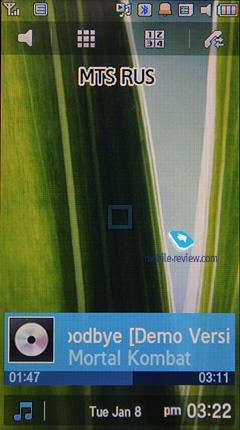
The player boasts the following filters: all tracks, recently played, most popular, artists, albums, genres and composers. The F330 also sports Album Arts support.
Speaking of new options, the player has obtained the rating system, enabling you to award any track with one to five stars. The maker has driven the integration with Windows Media Player as deep as it has never been before; actually, this manager also sports the rating system.
The bundled headset has a socket for plugging in custom earphones and ensures pretty good sound quality overall. Generally speaking, as a music-minded solution, the F490 comes close to Sony Ericsson’s Walkman range, especially as far as the first generation is concerned. The music key makes Walkman-branded handsets comes across our minds, as it allows the user to launch and minimize the player with one press. While at the standby screen, if you have the music player minimized, you will see its controls and current track title right on the display.
While in the loudspeaker mode, the F490 is not the best performer we have seen – it plays somewhat distorted sound and obviously lacks power, even though the sound doesn’t seem to be muffled.
The F490’s music quality with custom headphones plugged in is pretty good, although it ends up behind other Samsung-branded models – there is no point in considering it a music-minded solution, even though it packs a 3.5 mm audio input.
Back to the table of contents >>>
Watching video with the F490
Some words about how the F490 fares on the video front – thankfully, its widescreen gives it all it takes for a decent experience. The phone supports mpeg4, H.263 and H.264, which allows you to drag and drop movies onto the memory card. In fact, maximum file size is unlimited, at least in our tests we used 600-700 Mb movies and experienced no hardships with them.
But the biggest letdown here is also one of the best things about the F490 – its display. Sounds awkward, right? However, if your video is 240x320 pixels big, it won’t occupy the entire display, since the handset can’t fit the picture into the screen size, leaving black stripes on all sides. Where the Apple Touch excels, the F490 can’t make a movie look good. You can also opt for bigger video resolutions, but at the cost of having occasional freeze-ups and blockiness. The F490 is a contradictory device that has all the makings of a video-savvy solution, yet doesn’t provide a top-notch implementation for this department.
Back to the table of contents >>>
Picsel Viewer
Putting it short, Picsel Viewer is an application that opens MS Office files (for instance, MS Word, Excel, PowerPoint), Adobe Acrobat (PDF), picture and video formats on the phone. The attraction of this technology is its speed, when a 20 MB PDF file takes a couple of seconds to open, then you can quickly page through it, zoom in/out and rotate pages. No editing abilities here, only viewing is available with the F490, but that is pretty much enough already, especially considering there is no need in extra conversions.
Back to the table of contents >>>
Competition
In terms of positioning and spec sheet, the only direct rival to the Samsung F490 one can think of is the LG KU990. Previously we already said that the Samsung Armani is the maker’s reaction to the LG Prada (LE850), meaning that Samsung has assumed the role of the runner-up, which is otherwise very uncommon for it. The company enters the market much later, and, often, with solutions mimicking the competition, yet still somewhat weaker overall. Nevertheless, on many markets the brand of Samsung has more value to it, making up for missing features this way.
Let’s take a look how the Samsung F490 and the LG KU990 compare to each other spec-wise:
| |
Samsung F490 |
LG KU990 |
| Size, weight (mm, g) |
115x53.5x11.8, 102 |
103.5x54.4x14.8, 112 |
| Display |
3.2 inches, 240x432 pixels, TFT, 262K, touch-sensitive |
3 inches, 400x240 pixels, TFT, 262K, touch-sensitive |
| Camera |
5 Mpix, no auto-focus |
5 Mpix, auto-focus |
| FM radio |
No |
Yes |
| MP3 player |
Yes |
Yes, plus a remote in the sales package |
| microSD |
Hot-swap |
Slot perched under the battery |
| Profiles |
Yes |
Yes |
| Browser |
Advanced feature pack |
Basic functionality, looks pretty mediocre |
| Price |
350-370 Euro |
360-390 Euro |
For the LG Prada and Samsung Armani the problem of choice was all about brand preferences, rather than feature packs, in this case it is exactly the opposite. Given the KU990’s and the F490’s pretty much equal price tags, the LG phone seems to be the winner thanks to its superior camera, FM-radio and slightly more powerful standard applications. On top of that, its display can be handled either with a finger or a stylus, which is the next step in the development of capacitive touch screens.
On balance, while the KU990 and the F490 are in the same boat for ergonomics- and feel-wise, the former manages to come out on top, and with prices tags like these, the choice isn’t all that difficult to make – the LG Viewty is better than its vis-a-vis almost on every single front, which is an extremely rare occasion as far as Samsung is concerned.
At the beginning of this write-up we made a note that the Apple iPhone exercises a different philosophy, which doesn’t allow for a direct comparison with the Samsung F490. However, since 400-430 Euro will buy you one of these here in Russia (unofficial supplies), the iPhone gets to be a real alternative to the Samsung F490 and the LG Viewty. The good thing about it is that it is very heavy on multimedia, specifically video and music, plus it has a neater interface, on the downside, the iPhone simply doesn’t deliver as far as the standard phone features go (calls, SMS). Thinking of it from the standpoint of fashion, Samsung’s offspring, and, let’s be honest, LG too, are totally trumped by the iPhone. So, while these phones are very different essence-wise, we would recommend going for the Apple iPhone as a reasonable choice for pretty much the same money.
Back to the table of contents >>>
Impressions
The reception quality was never an issue with the Samsung F490, as it was in line with other offerings available in this class. Our ring tones had average volume or a tad lower than that – we would miss our calls even with the Armani in our pocket often enough. The vibro alert was moderate strength-wise, retaining no edge over other Samsung-branded solutions.
The handset retails for 370 Euro, which is around 90-100 Euro off the Samsung F700’s price. I, for one, suggest picking the senior solution only in case you crave for a thumbboard – as for the rest, these two are very resembling.
Like we said at the beginning, the F490 represents an attempt to come up with a touch-sensitive phone aimed at impulse-drive purchases. And it is a good shot, yet by no means perfect. Solutions like this can’t be vastly popular, for they target only a particular niche. The F490 will enjoy reasonable sales on the market, but with no hopes for becoming a best seller, though. Being pushed by the LG Viewty and having to cope with the Apple iPhone (even though it is not official in most regions), the F490 won’t be able to display its full potential. So, the best way to look at it is one of the first Croix OS based phones – the impending solutions are going to be much more interesting.
Related links:
Back to the table of contents >>>
Eldar Murtazin (eldar@mobile-review.com)
Translated by Oleg Kononosov (oleg.kononosov@mobile-review.com)
Published — 25 January 2007
Have something to add?! Write us... eldar@mobile-review.com
|
News:
[ 31-07 16:21 ]Sir Jony Ive: Apple Isn't In It For The Money
[ 31-07 13:34 ]Video: Nokia Designer Interviews
[ 31-07 13:10 ]RIM To Layoff 3,000 More Employees
[ 30-07 20:59 ]Video: iPhone 5 Housing Shown Off
[ 30-07 19:12 ]Android Fortunes Decline In U.S.
[ 25-07 16:18 ]Why Apple Is Suing Samsung?
[ 25-07 15:53 ]A Few Choice Quotes About Apple ... By Samsung
[ 23-07 20:25 ]Russian iOS Hacker Calls It A Day
[ 23-07 17:40 ]Video: It's Still Not Out, But Galaxy Note 10.1 Gets An Ad
[ 19-07 19:10 ]Another Loss For Nokia: $1 Billion Down In Q2
[ 19-07 17:22 ]British Judge Orders Apple To Run Ads Saying Samsung Did Not Copy Them
[ 19-07 16:57 ]iPhone 5 To Feature Nano-SIM Cards
[ 18-07 14:20 ]What The iPad Could Have Looked Like ...
[ 18-07 13:25 ]App Store Hack Is Still Going Strong Despite Apple's Best Efforts
[ 13-07 12:34 ]Infographic: The (Hypothetical) Sale Of RIM
[ 13-07 11:10 ]Video: iPhone Hacker Makes In-App Purchases Free
[ 12-07 19:50 ]iPhone 5 Images Leak Again
[ 12-07 17:51 ]Android Takes 50%+ Of U.S. And Europe
[ 11-07 16:02 ]Apple Involved In 60% Of Patent Suits
[ 11-07 13:14 ]Video: Kindle Fire Gets A Jelly Bean
Subscribe
|



